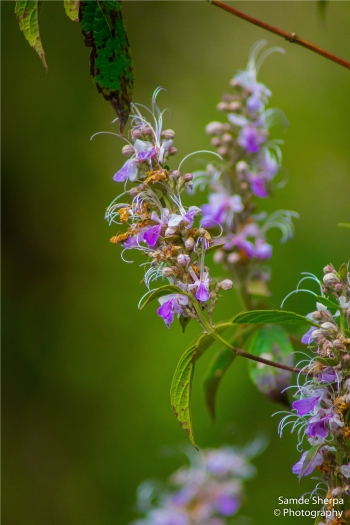Incense Bluebeard
(Pseudocaryopteris bicolor)
Incense Bluebeard (Pseudocaryopteris bicolor)
/
/

Samde Sherpa
CC BY-SA 3.0
Image By:
Samde Sherpa
Recorded By:
Copyright:
CC BY-SA 3.0
Copyright Notice:
Photo by: Samde Sherpa | License Type: CC BY-SA 3.0 | License URL: https://creativecommons.org/licenses/by-sa/4.0 | Uploader: Samde Sherpa | Publisher: Wikimedia Commons |





Estimated Native Range
Summary
Pseudocaryopteris bicolor, commonly known as Incense Bluebeard, is a deciduous shrub native to open woodlands and grasslands in South and Southeast Asia. It typically grows to a height of 6-10 feet (1.8-3 meters) and a width of 5-9 feet (1.5-2.7 meters). The plant has an upright, multi-stemmed form and produces striking two-toned flowers, with purple calyces and white corollas, which bloom in late winter to early spring, adding color to the garden when few other plants are in flower.
Incense Bluebeard is valued for its winter and spring flowering period, providing visual interest during a time when many plants are dormant. It is used in cultivation for ornamental borders, as a specimen plant, or for adding height to mixed plantings. This shrub prefers full sun but can tolerate part shade, and it requires well-drained soil. While it is relatively low-maintenance, occasional pruning after flowering can encourage a more compact growth habit and enhance its appearance.CC BY-SA 4.0
Incense Bluebeard is valued for its winter and spring flowering period, providing visual interest during a time when many plants are dormant. It is used in cultivation for ornamental borders, as a specimen plant, or for adding height to mixed plantings. This shrub prefers full sun but can tolerate part shade, and it requires well-drained soil. While it is relatively low-maintenance, occasional pruning after flowering can encourage a more compact growth habit and enhance its appearance.CC BY-SA 4.0
Plant Description
- Plant Type: Shrub
- Height: 6-10 feet
- Width: 5-9 feet
- Growth Rate: Moderate
- Flower Color: Purple, White
- Flowering Season: Winter, Spring
- Leaf Retention: Deciduous
Growth Requirements
- Sun: Full Sun
- Water: Medium
- Drainage: Medium
Common Uses
Bee Garden, Border Plant, Butterfly Garden, Low Maintenance, Potted Plant
Natural Habitat
Native to open woodlands and grasslands in South and Southeast Asia
Other Names
Common Names: Bluebeard
Scientific Names: , Pseudocaryopteris bicolor, Caryopteris wallichiana, Caryopteris odorata, Caryopteris bicolor, Clerodendrum odoratum, Caryopteris odorata var. integrifolia, Volkameria odorata, Caryopteris odorata f. albiflora, Clerodendrum odoratum f. albiflora
GBIF Accepted Name: Pseudocaryopteris bicolor (Roxb. ex Hardw.) P.D.Cantino